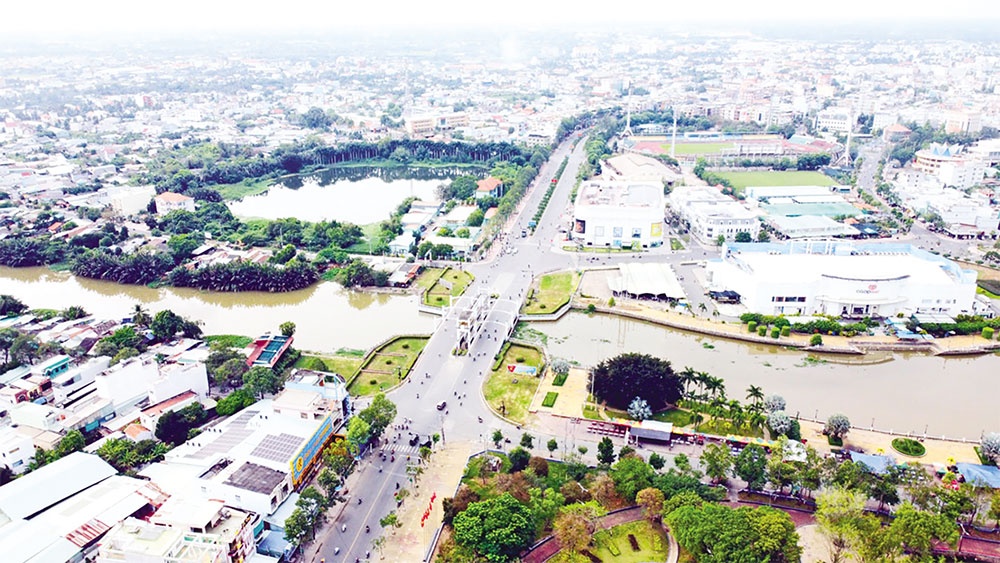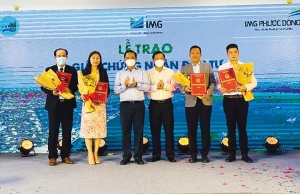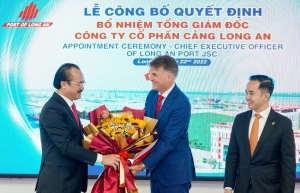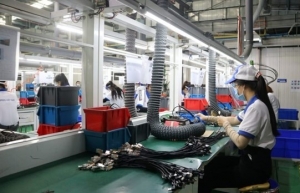Long An leading delta region with seamless infrastructure
The specific targets have been enshrined in the resolution of the ninth Long An Party Committee Conference for the 2020-2025 tenure. To make these ambitions come true, Long An has set forth three breakthrough programmes for implementation during the period.
The programmes include developing high-tech agriculture linking to sector restructuring; human resources development to satisfy local burgeoning requirements for industrial and agricultural development; and mobilising resources into constituting synchronous transport infrastructure for industrial and urban development in the province’s key economic zone.
Simultaneously, Long An commits to completing the construction of three key works during the period – Tan An city’s belt road, provincial road 830E, and provincial road 827E.
 |
| By 2025, more bridges and roads will be upgraded or built to high urban standards |
The first programme on developing high-tech agriculture was initially set by Long An’s management authorities as a breakthrough programme at Party Committee conferences in 2016. According to Long An Department of Planning and Investment (DPI), the programme has harvested inspiring results, helping to bolster the quality of agricultural produce and gearing production towards increasingly meeting the market needs.
Long An also succeeds in forming advanced high-tech models in agricultural production which have been transferred for widespread application. Many locations across the province have shifted their production models, striving to shape specialised, large-scale material growing areas closely attached to processing and consumption in value chains.
As of now, Long An has created 22 safe food supply chains selling a wide range of products from fruit, vegetables, and rice to pork and chicken. Nearly 1,500ha belonging to 76 units have reached VietGAP standards for rice, vegetables, meat, and seafood products.
Around 65 units have applied globally-recognised quality management systems in agricultural item processing, and four businesses have been honoured as high-tech agri-units.
Many key items such as lemons, bananas, and rice have also made inroads in demanding markets worldwide, such as the US, EU, Japan, and South Korea.
Currently, nearly 30,000ha of rice utilises high-tech production, a figure that is hoped to be doubled by 2025. Vegetable areas with high-tech application now cover over 1,800ha, striving to reach 2,000ha by 2025. Corresponding areas for thanh long fruit are almost 4,000ha currently and 6,000ha by 2025.
In order to meet local burgeoning demands for industrial and agricultural development attached to economic restructuring, during 2020-2025, the province puts emphasis on developing sufficient and quality manpower with a radical job structure.
By the end of the period, up to 75 per cent of labour attached to industrial and agricultural production will be trained, with 35 per cent holding diplomas or other relevant certificates.
Trained areas include new material production, quality control, energy efficiency and conservation, mechanical engineering, electronic and ICT engineering, automation, food processing, yarn and fabric processing, and more besides.
In addition, efforts are gearing towards perfecting policies and mechanisms to spur human resource development, applying breakthrough policies for talent attraction and retention, along with creating a conducive environment for capable people to best avail of their capacity.
In the past couple of years, Long An has concentrated diverse resources into building a synchronous transport system all over the province and major roads heading to Ho Chi Minh City and other localities in the vicinity.
Key projects cover building Luong Hoa-Binh Chanh road reaching urban road standards; building Huu Thanh-Tan Bui road with six lanes for motor vehicles and four mixed lanes; building provincial road 826E with six lanes; a 2km road linking Rach Doi Bridge to provincial road 826E; and building Duc Hoa road with four lanes; among others.
According to the DPI, building a road in Tan An city from Hung Vuong T-junction to national highway 62, and upgrading provincial road 824, will both source capital from the state budget. These two projects aim to see construction started imminently.
The remaining roads will be built by sourcing capital from developers of these relevant projects. They will soon complete construction planning to fill for procedures seeking investment proposal approval, and qualified projects will come up with bidding procedures this year.
All projects and works are planned to seamlessly connect to local industrial zones, clusters, and urban areas.
According to Long An Department of Transport, during 2020-2025, the total capital to make these key infrastructure projects and works come true comes to around $1.3 billion, of which 62 per cent or nearly $800 million will come from state coffers, and the remaining 38 per cent equal to around $505 million will be raised from assorted sources.
Huynh Van Son, director of the DPI, noted that in light of the province’s development orientation, the province aims to best avail of its strategic position close to Ho Chi Minh City to rise into a big industrial, urban, and logistics service centre in the Mekong Delta region.
Doing business in Long An, Son hopes investors will find it easy to connect to the rest of the country and worldwide, making it convenient to facilitate import-export, save on time and cost, and boost competitiveness.
“With favourable geographical conditions and a comprehensive transport system with an international seaport, border crossing, and key roads, Long An converges all the conditions for investors in IZs and clusters to thrive,” Son noted.
 | Long An cultivating strong pro-business environment As part of the Mekong Delta region, Long An province allures investors not only by virtue of its favourable position adjoining Ho Chi Minh City and constantly improved local infrastructure, but also by its commitment to support businesses and investors |
 | Long An International Port appoints new CEO On July 22, chairman of the Management Board of Long An Port JSC Vo Quoc Huy announced the decision to appoint Peter Hendrik Slootweg as the company's CEO. |
 | Long An seeks to attract more Japanese investors The People’s Committee of the Mekong Delta province of Long An on August 23 held an investment promotion conference and a dialogue with Japanese enterprises. |
What the stars mean:
★ Poor ★ ★ Promising ★★★ Good ★★★★ Very good ★★★★★ Exceptional
Related Contents
Latest News
More News
- Global partnerships key to Vietnam’s IFC development (December 26, 2025 | 16:18)
- Vingroup pulls out of bid to invest in North-South high-speed railway (December 26, 2025 | 11:42)
- Strengthening supply chains through trade promotions and customs reform (December 24, 2025 | 14:00)
- PM orders investment model for North–South high-speed rail (December 22, 2025 | 17:43)
- LS Eco Energy to invest in Vietnam rare earth sector (December 22, 2025 | 17:31)
- Government moves to establish International Financial Centre (December 21, 2025 | 21:00)
- Vietnam's IFC to target global investment flows (December 21, 2025 | 18:00)
- Two national hospitals expand capacity with new facilities (December 20, 2025 | 09:00)
- Ha Tinh breaks ground on major Vingroup industrial and energy projects (December 19, 2025 | 18:24)
- EVN launches major power infrastructure projects nationwide (December 19, 2025 | 18:17)

 Tag:
Tag:




















 Mobile Version
Mobile Version